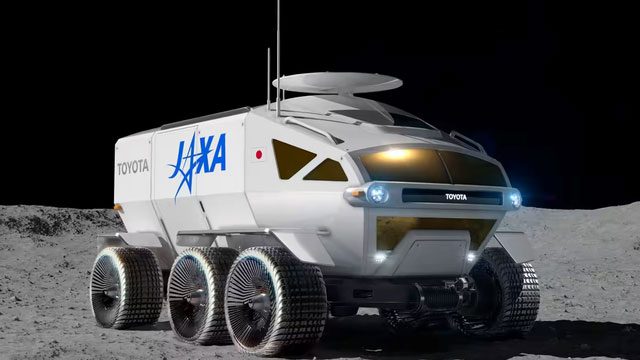These vehicles may be used for the Artemis Project led by the United States, aiming to send humans to the Moon by 2025. This will mark the first time humans return to the Moon since 1972.
The exploration vehicles are expected to be sent to the Moon in 2029. Two companies held a press conference on Friday (July 21) alongside the Japan Aerospace Exploration Agency (JAXA) in Tokyo. Coincidentally, it was also the day that Apollo 11 landed on the Moon 54 years ago.
Toyota began collaborating with JAXA in 2019 to develop a prototype lunar exploration vehicle named Lunar Cruiser. The prototype is named after Toyota’s four-wheel vehicle, the Land Cruiser, designed to operate in harsh environments such as deserts and rugged mountainous terrains. This is Toyota’s first progress report on their space program in four years.
The Lunar Cruiser will travel a total of over 10,000 kilometers on the Moon for exploration activities. The Japanese automotive giant revealed four key features of the vehicle: using regenerative fuel cells (RFC); off-road driving capabilities; autonomous driving; and user experience.

Lunar Cruiser lunar exploration vehicle.
RFC is a type of automotive battery made from hydrogen converted using electrolysis from solar energy, being developed by MHI in collaboration with JAXA and the Japan Agency for Marine-Earth Science and Technology.
On the Moon, where day and night last for two weeks, the technology for continuously regenerating batteries during the day is crucial, just as the fuel cell technology that Toyota has applied to their vehicles on Earth.
Ken Yamashita, the lunar exploration project leader at Toyota, stated that RFC has a significant advantage because the size and weight of the batteries needed to produce the same amount of energy are much smaller than lithium-ion batteries.
While developing RFC technology for space use, Toyota also intends to apply it on Earth. Energy from water and sunlight alone can be utilized as a power source in remote islands or during natural disasters, and it is expected to contribute to carbon neutrality.
The vehicle will also be equipped with a living space of approximately 7 square meters, where passengers will not need to wear space suits. Since astronauts will spend about a month in this compact space for exploration, the companies plan to design it for maximum comfort by leveraging expertise from their regular business operations.
MHI has applied its knowledge to a zero-gravity environment, taking into account the pressure difference between the crewed cabin and the outside where astronauts will conduct exploration activities.
Yamashita added: “This is also important when we consider how people will spend time in the cabin when they are no longer driving but letting the vehicle drive autonomously.”
Atsushi Nakajima, project manager at MHI, stated that the company is considering producing the lunar exploration vehicle weighing approximately 10 tons at their factory two to three years before the launch.
Toyota mentioned that they look forward to expanding partnerships related to their space business in the future. The company has collaborated with Bridgestone to develop metal tires that can run on the surface of the Moon.
“We are discussing security agreements with several companies during the development phase and want them to become popular at the right time,” Yamashita said.





















































